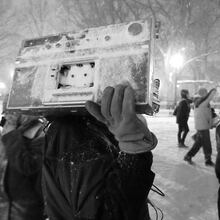ART REVIEW
“In the Remembering”
Through Jan. 2. 11 a.m.-5 p.m. Tuesdays-Fridays; noon-5 p.m. Saturdays. Free. Sandler Hudson Gallery, 1000 Marietta St., Suite 116. 404-817-3300, www.sandlerhudson.com.
Bottom line: Autobiographical material yields some expected and also some more inspired results in this solo show.
It’s an incredible track record for an artist: 17 solo shows at one gallery.
Atlanta artist Mario Petrirena’s circumstance is an uncommon one when so many artists hop from gallery to gallery over the course of their careers, or see their longtime galleries shuttered. Petrirena is certainly one of the lucky few. He’s been with Sandler Hudson Gallery on Atlanta’s Westside for the gallery’s 25-year existence — a situation that feels charmed in an art scene so perpetually in flux.
What Sandler Hudson offers Petrirena is support for what has largely been an unwavering pursuit in this artist’s long career: an examination of the emotions, the sense of loss and nostalgia that occasions leaving one’s place of origin, never to return. At age 8, Petrirena fled his native Cuba for America, living for a time in an orphanage before he could be reunited with his parents. His artwork tends to reflect on that personal history, appraising the situation of having a foot in two worlds, the past and the present, Cuba and America.
His latest show at Sandler Hudson, “In the Remembering,” is a collection of sculptures, collages and assemblages of found objects that revisits the artist’s stock-in-trade ideas of home, remembrance, memory and regret.
Vintage photographs — as one might expect — loom large as an emotional touchstone for Petrirena. When one’s mission is to talk about the past, few items have the relic value of time-worn wedding photos, portraits and other such emotion-infused mementos.
Black-and-white photographs of a series of modest homes are the centerpiece of the assemblage sculpture “Seasons of Darkness.” Those photographs of wood and brick shelters are arranged in a circle inside a small wooden house placed on a pedestal. The small structure’s absent roof allows us to look down into its center to view those homes. Broken glass rings the perimeter. It’s hard to miss the metaphor, of a broken home, of some psychic trauma linked to an idea of home, now shattered.
Much of Petrirena’s work, in this and other ways, strives to articulate the sensation of remembering, and memory itself, a slippery, wily beast. His collage “Of Complicated Doubt” is a characteristic expression of memory, seen as a series of layers and barriers. In that collage piece, four subjects have had their identities obscured by circles placed like masks over their faces. A rusty metal cage is placed over those portraits to further distance and deform. The artwork’s metal armature suggests entrapment. But “Of Complicated Doubt” also conveys the layers of time and space that alter our experience of the past.
Petrirena’s work is often reminiscent of a time in the Atlanta art scene when every artist seemed to be plumbing autobiographical content to create little personal shrines decorated with buttons and lace and family photos. Like so many of those artists entranced by old and weathered things, Petrirena can often appear to be so invested in his stuff: in the patina of wood and marble, old bottles and jars and found bits of cultural detritus, that he becomes lost in the romance of his own materials.
For the most part in “In the Remembering,” Petrirena has, thankfully, pared back and simplified, though certain works like “memory jars” of three large pickling jars filled with plastic Jesuses, fake flowers, swizzle sticks, beads, seashells, demitasse cups, buttons and other curios verge on kitsch. Whoever first used such object-filled vessels to evoke memory may have been onto something, but the device is by now so overworked it has reached the point of cliche.
When Petrirena moves away from his romance-steeped kit-bag and embraces more abstract sculptural works, he often shines, unmoored from so much brooding materiality. His sentinel-like sculptures in clay nicely convey a sense of solitude and remembrance. One of his best works is an eerie little sculpture, “Of Dreams That Were,” a black clay silo that looks like a spent warhead. Peer inside its flat hull, and tiny, pained bas relief faces erupt from its surface. It’s a haunting work, something raw and rich in a show that flirts with profundity and sometimes achieves it.
About the Author



